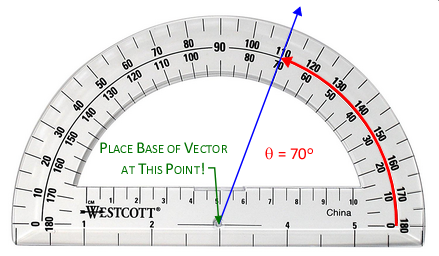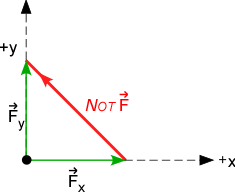- Computers are NOT needed for lab this week
- Vector addition on a force table
- Make sure there are enough protractors available (one per student)
- My solutions can be found here
- The force tables sitting on top of the lab bench can be easily read by someone of height 6 ft. or taller. Students may find it easier to read the angles correctly by standing on a step stool, or sitting on top of the lab bench
- A round bubble-level is used to level the force tables. Place the bubble level just below the center pin, and leave it there
- Problems encountered, and they are legion:
- During the Fall 2018 semester, I found that there was an error in that the masses were not necessarily their stamped value. It affected the Torque experiment more than Vector Addition, but as of Fall 2019 all masses and hangars were checked and the ones in error were labeled and buried at the bottom of the box of masses
- The instructions clearly show & state that students should use the force table with 0° in the 3:00 o'clock position, and that they'll use the inner scale for their measurements (photos). Someone will still get this wrong, so be sure to check all groups once they have mass hanging from the three strings
- When measuring on the force table, students should get 130-g at 260° for the equilibrant. If they are significantly different, they likely have counted the wrong number of masses to use on one of the other strings
- They use the protractor incorrectly by not placing the zero-point of the protractor at the origin of their vectors. This can add up to an error of 5° or 6°
- I've added a picture showing the correct usage of a protractor to the instructions (Figure 1). Hopefully it will minimize this problem
- They will add vectors incorrectly, as shown in Figure 2 below, even though I have it written on the board as NOT the correct way to add vectors
 |
 |
| Figure 1 |
Figure 2 |
- A special set of masses and hanger, specific to these force tables, are used
- Sometimes the hook on the mass hanger loosen from the base. Make sure they're screwed in tight
- The masses are designed so that they will not fall off the mass hanger; as a result, they must be removed one at a time by sliding them up the hanger hook shaft
- Each green box contains a set of masses and a hanger. The distribution of masses are written on the underside of the green box lid; please ask students to properly return the masses to each box
- Remind students that the hangers have a mass of 50-g, which must be included in their calculations!
- Contents of each mass set:
- (1) 50-g mass hanger
- (9) 20-g masses
- (1) 10-g mass
- (2) 5-g masses
- One discussion question asks about the smallest mass increment provided (5-g). There is sufficient friction in the pulley's that requires at least this amount to overcome
- I tested this by using two of the strings to hang mass directly opposite each other on the force table. I put a full stack of masses at 90° and 270° and made sure they were balanced. Placing an additional 5-g at 270° did not cause the system to become unbalanced. I think that additional friction occurs in the pulleys when they are loaded and the plastic wheel is pressed down on the metal axle.
- (As of Fall 2023, they just use regular graph paper to draw their vectors. Centimeter-ruled paper is no longer used.)
- They use centimeter-ruled graph paper for their graphical vector addition. Before lab, I keep it on the short bench next to the sink so that they don't use it for writing their lab journals. More can be found in the "Graph Paper" file cabinet drawer in the Physics office
|

